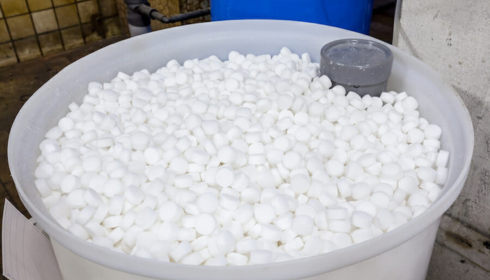If you’ve ever stood in the aisle staring at bags labeled “salt” and “potassium chloride,” wondering which one your water softener really needs, you’re not alone. It’s one of those small household choices that feels technical but can actually influence your health, plumbing, and even your garden. Let’s talk about it in plain English — the kind of talk you’d have with your neighbor over the fence, not in a chemistry lab.
The Basics — Why Softeners Need Salt in the First Place
Water softeners are clever little machines that swap out hard minerals like calcium and magnesium for sodium or potassium. Those hard minerals are what cause that cloudy film on your dishes, the crunchy towels after washing, and the scaly residue on faucets.
To make this swap, the softener’s resin beads need something to trade with — and that’s where salt (sodium chloride) or potassium chloride steps in. The salt essentially “recharges” the system, helping it flush out the hardness and keep your water silky smooth.
But here’s the catch: the type of salt you use changes the story. That’s where the potassium chloride vs sodium chloride water softener debate starts heating up.
Potassium or Sodium — What’s Really Going Into Your Water?
Sodium chloride is the most common and affordable choice. It works great, is easy to find, and has been used for decades. However, since it’s sodium-based, some homeowners worry about how much sodium it adds to their water, especially if they’re watching their salt intake for health reasons.
Potassium chloride, on the other hand, is like the eco-friendly cousin. It’s a natural nutrient that plants and bodies actually need — just in moderation. It works in the same way as sodium chloride in softeners, but instead of adding sodium to your water, it adds potassium.
That might sound like a minor swap, but for people with dietary restrictions or those using softened water for gardens, the difference can matter quite a bit.
The Health Angle — Does It Really Matter?
If you’re healthy, the sodium from a softener isn’t typically a big deal. We’re talking about small amounts. But if your doctor’s ever told you to keep an eye on your salt intake, potassium might be worth a look.
Softened water doesn’t taste salty (or shouldn’t), but every glass does carry trace amounts of whatever you’re using in the softener tank. Over time, those small bits can add up — particularly for those who drink a lot of water or cook with it regularly.
Switching to potassium for water softener systems can reduce that sodium intake without compromising the benefits of soft water. It’s a bit like swapping your table salt for sea salt — small change, but meaningful for some.
Environmental Side of the Story
Now, let’s step away from the kitchen for a moment and look outside. When your softener flushes out minerals during regeneration, it sends waste water into the drain — and sometimes into your garden or local water system.
If you’re using sodium chloride, that discharge carries sodium, which can build up in soil over time. High sodium levels make it harder for plants to absorb water and nutrients. Potassium chloride doesn’t have that issue — it actually feeds the soil instead of stressing it.
That’s one reason more eco-conscious households and cities are promoting potassium over sodium. It’s gentler on the environment, septic systems, and even your backyard herbs.
Cost and Efficiency: Where the Trade-Off Happens
Here’s where things get tricky. Potassium chloride is usually more expensive — sometimes 2–3 times the price of standard salt. And it’s a little less efficient at regenerating resin beads, meaning your system might use slightly more product or regenerate more often.
That might sound like a dealbreaker, but for households that prioritize health or sustainability, it’s an acceptable trade. For others, especially those on larger systems or well water, the cost difference can be noticeable.
To put it plainly, this isn’t a one-size-fits-all decision. The “right” option depends on what you care about most: cost, health, or environmental impact.
Real-World Comparison
Let’s break it down with a simple example. Imagine two neighbors:
- John uses sodium chloride because it’s cheap and works just fine. His plants are in pots, so runoff doesn’t bother him. He drinks bottled water anyway.
- Lisa uses potassium chloride because her family drinks tap water daily, and she waters her vegetable garden with softened water. She pays more for potassium, but it aligns with her lifestyle.
Both are right. Neither is wrong. It’s about finding your balance, not chasing perfection.
The Chemistry Doesn’t Lie
Technically speaking, potassium chloride and sodium chloride perform almost identically when it comes to water softening. Both remove hardness effectively. Both keep your pipes and appliances free from mineral buildup. The difference lies not in performance, but in what they leave behind and how they interact with your environment.
So when people argue about potassium chloride vs salt for water softener, they’re not debating functionality — they’re comparing priorities. One’s about efficiency and cost; the other’s about health and sustainability.
Final Thoughts — Choose What Fits You Best
If there’s one takeaway, it’s this: don’t overcomplicate it. Whether you use potassium or sodium, both options will soften your water beautifully. The key is to make an informed decision based on what feels right for your home.
If your main concern is budget and simplicity, stick with sodium chloride. If you want to reduce sodium exposure and do your part for the environment, potassium chloride is worth every extra dollar.
Either way, you’ll still enjoy what matters most — cleaner dishes, softer laundry, and a shower that finally feels like a small luxury.
Because at the end of the day, the choice isn’t really about chemistry. It’s about comfort, health, and the kind of home you want to build — one glass of water at a time.

